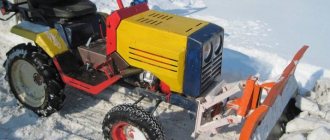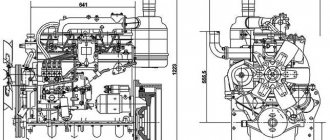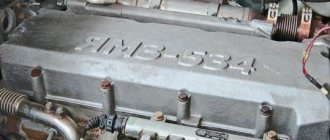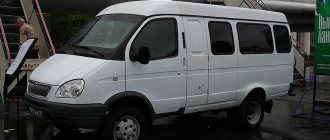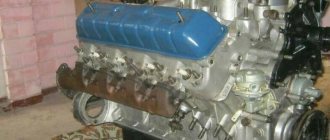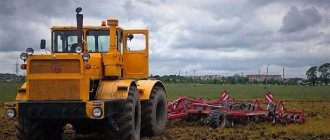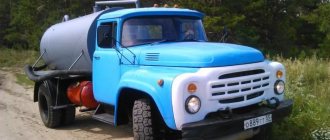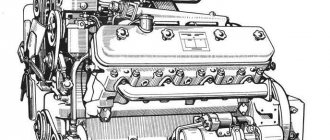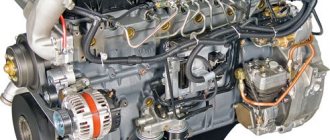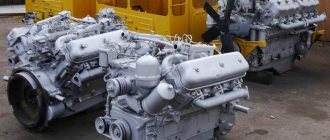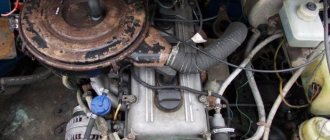Tractor T-40: technical characteristics
"Sorokovka" - versatility, reliability and performance!
T-40 - among villagers, farmers and working people in the vastness of the former USSR, it is difficult to find a person who was not at least familiar with this legendary tractor!
This machine made its debut back in 1961 , becoming the founder of a whole range of agricultural equipment produced by the Lipetsk Tractor Plant in subsequent years.
The experience gained during the creation and further operation of the T-40 served as the foundation for the creation of the entire line of wheeled tractors that rolled off the LTZ assembly line in subsequent years.
Despite the fact that the production of this hard worker was discontinued back
in 1995 , thousands of these tractors still continue to work quite successfully in the fields of our country.
Tractor T-40: the birth of a legend
The Lipetsk Tractor Plant was created during wartime in 1943, on the basis of surviving workshops.
On the instructions of the State Defense Committee, the goal was to create an agricultural tracked row crop tractor of medium power. For the needs of the plant, technologists, engineers, designers and workers of the necessary specialties were urgently recalled from the front.
The first product of the plant was the KD-35 tractor , the first production models of which arrived at the country's state farms by the end of 1944. Until the beginning of the 60s,
113,600 units , after which the plant switched to the production of wheeled tractors.
Work on the first wheeled tractors began in 1956; these were self-propelled chassis with a double-beam frame and a rear-mounted power plant. But the real predecessor of our hero was the T-25 (not to be confused with Vladimirovts) developed in 1958 and went into production in 1960 under the designation T-30 and then in the same year T-35 with a more powerful engine.
Mass production began with the T-40 universal row-crop tractor produced in 1961.
“Sorokovka” absorbed all the leading experience and very quickly became a real bestseller in the Soviet tractor industry! In general, during the period from 1961–1995, more than a million T-40 tractors and its modifications were produced!
Tests carried out in 1970 showed that this machine proved to be one of the best in terms of reliability in the USSR, and also won gold medals at European exhibitions from 1966 to 1970, held in Markkleeberg and Leipzig.
Technical characteristics of T-40
- Engine power - D-37, D-144 37; 50 hp
- Structural weight - 2.3–2.6 tons.
- Speed range - 1.6–27 km/h.
- Number of forward/reverse gears — 7/7
- Traction class tractor - 0.9 t.p.
- Dimensions d/w/h - 3660/1620/2100 mm.
- Agrotechnical clearance - 500 mm.
- Adjustable track - 1200–1800 mm.
Engine
“Sorokovka” was equipped with engines from the Vladimir Tractor Plant. The basic T-40 was equipped with a D-37 power plant with a power of 37 hp. The later modification of the T-40M was equipped with the D-144 diesel engine with a power of 50 hp.
Both of these engines are four-stroke, four-cylinder, air-cooled diesel engines. The engine design does not have a crankcase, and the removable in-line cylinders are equipped with radiator fins for better heat dissipation.
For better oil cooling, an additional oil cooler was installed, since air cooling was clearly not enough in hot weather. In the winter season, it was recommended to disconnect the radiator from the oil system, but in the summer everything was returned to its original state. Temperature control was carried out using a corresponding sensor on the instrument panel.
The diesel engine had mainly an electric starter; less often, a PD-8 gasoline starting engine was installed.
Despite the shortcomings in the cooling system, the power plants with which the T-40 and its modifications were mounted, with proper operation and timely maintenance, are still considered quite reliable.
Transmission
The T-40 tractor and its modifications were equipped with a four-way, eight-speed (one slow gear), manual transmission.
The presence of reverse (the ability to move in all gears, both forward and backward) made the Sorokovka more maneuverable and increased productivity.
A distinctive feature of the box was the arrangement of the shafts located transversely - this made it possible to significantly shorten the structure and combine it in a single unit with the rear axle mechanisms. This solution made it possible to significantly reduce the dimensions of the tractor.
The front wall of the transmission is connected to the clutch housing, and also has threaded connections for installing some machine controls.
On the rear wall of the box there are fastenings for installing hitch arms, and a PTO extension is also installed. The brake hoses are attached to the sides.
Levers and mechanisms for controlling gears, differential and reverse are located on the cover of the upper part of the box.
Chassis
The tractor is supported by the front and rear axles. The front axle serves as a support and serves to change the direction of the wheels using the steering. The rear wheels convert the torque transmitted by the engine into tractor movement.
Additional weights can be installed on the wheels to increase the grip weight of the tractor if operating conditions require it.
The pressure maintained in the tires should be approximately 0.10–0.14 MPa, depending on what work you will be doing and what attachments you will be using.
It is possible to install the wheels “inside out”, which allows you to significantly expand the track, for example, for working on steep slopes, from 1200 – 1800mm . The agricultural clearance is also adjustable and ranges from 500–650 mm .
Steering
All models of the T-40 tractor are equipped with power steering (power steering). The signal to the hydraulic booster is transmitted by the steering column via cardan shafts. Meanwhile, the power steering sends force to the bipod, thereby turning the wheel to the right or left.
T-40 cabin: overview
The cabin is single, closed, made of panels connected by spot welding. The pipe frame ensures safety when tipping over.
A fairly good overview allows you to perform agricultural work efficiently. The windshield is equipped with a windshield wiper.
The roof is made of plywood and covered with substitute leather. There is a lampshade installed on the right, a fan on the beam in front, and a mount for a thermos in the left corner at the back.
All main controls are located in front of the tractor driver. The reverse, gear shift and PTO levers are located on the cab floor. You will find the hydraulic control knobs to the right of the steering column.
The pedals have a classic layout. The brakes are separate, connected by a special bar.
On the panel on the left are sensors for monitoring various parameters: oil pressure and temperature, battery charge, air pressure.
In general, all the main controls are located quite conveniently and accessible. As they say, everything is at hand, and control devices are before your eyes.
Attachments for tractor T-40
The rear linkage is designed for mounting various attachments on the T-40. This is a hinge mechanism with a central and two longitudinal rods.
The longitudinal rods are connected to the levers on the shaft using braces; a crank connected to the hydraulic cylinder is mounted on the same shaft.
The hydraulic cylinder raises and lowers the towed equipment, and its position is adjusted using braces and a central link.
It is possible to install various agricultural equipment, equipment for forage procurement, land cultivation, vegetable cultivation and inter-row cultivation. It is possible to install a loader with a maximum load capacity of up to 800 kg .
Modifications of the T-40 tractor
“Sorokovka” has been modernized and improved more than once over all the years of production. With each modernization, changes were made to its design to expand the functionality of this wonderful machine.
For convenience of consideration, we will divide all modifications according to the type of power plant into two groups:
Tractors with D-37 engine:
- T-40A – it was distinguished from the basic version by the presence of all-wheel drive; this innovation was appreciated by road services, among whom the tractor quickly gained popularity.
- T-40AN is an all-wheel drive vehicle with reduced agricultural clearance, specially designed for working on steep slopes.
- T-50A is a modification designed to work with a mounted loader. The model was intended for use in industry.
Tractors with D-144 engine:
The appearance of the D-144, a more powerful 50- horsepower engine, made it possible to increase the productivity of the tractor and provoked the emergence of new modifications.
Externally, the cars with the D-144 were distinguished by a rectangular hood, while its brother with the D-37 had a slightly rounded hood at the front.
- T-40M is a rear-wheel drive model.
- T-40AM is a model with all-wheel drive.
- T-40ANM - by analogy with the T-40AN, it was intended for work on slopes.
- T-40AP - was created taking into account the installation of municipal equipment on it.
Operating experience of the T-40: advantages and disadvantages
Having learned a little about the history of the appearance of the “hero” of our story, familiarized with its technical characteristics and design, and examined the model range. We can draw some conclusions about the advantages and disadvantages of this hard worker, and also ask people who know this tractor firsthand about this.
Let's start with the pros:
- This is a truly multifunctional, reliable machine with excellent cross-country ability. The ability to install a loader further expands the machine's capabilities.
- The tractor maintains functionality and maneuverability both at high speeds and when reversing. It showed itself well in limited areas, in greenhouses.
- All modifications have power steering.
Speaking about the shortcomings, we note:
- The air cooling system does not always cope with its function, especially in hot weather. In winter, on the contrary, problems arise with starting the engine.
- Lack of comfort in the cabin; without modifications it is quite cold in winter and very hot in summer.
Many tractor drivers themselves modify their Sorokovkas, thereby reducing design flaws to a minimum:
Improvement of the cooling system.
One of the options for solving the cooling problem yourself. In this case, the tractor driver replaced the standard oil radiator with a larger volume radiator and secured it on the right side of the engine, additionally installing a fan from a foreign car through a toggle switch.
Oil supply is carried out using conventional hydraulic hoses. In addition, cylinder cooling is improved because nothing obstructs the air flow. The radiator is hinged for access to the engine.
Cabin heating.
There are two main, most widespread options for heating the T-40 cabin. The easiest way to make heating is from exhaust gases or from an oil radiator.
Let's sum it up
In conclusion, we can say that the T-40, in spite of everything, back in 1961, took a leading position in its traction class, and until production ceased in 1995, it quite adequately fulfilled the duties assigned to it. And these tractors still work on our fields, providing worthy competition to modern models.
In addition, in the process of work, vast experience was accumulated, which was subsequently used in the creation of the LTZ-60 and other models.
On the secondary market you will still find many offers for the purchase/sale of magpies. A working copy can be purchased in the range from 80–250 tr. depending on the condition, required investments and availability of attachments.
tractorreview.ru
Unit gearbox design
Representatives of the T-40 family were equipped with an 8-speed four-way manual gearbox, which had one slow gear.
Despite the considerable weight of the tractor, the presence of a reverse gearbox made it quite maneuverable and also significantly increased the performance of the unit. The difference between the gearbox was the transverse arrangement of the shafts and manual adjustment of the valves. Thanks to this, the design of the gearbox was slightly shortened and combined into one device with elements of the rear axle. As a result, it was also possible to achieve a reduction in the weight of the gear shift mechanism.
The front transmission baffle is attached to the clutch housing, so the driver must fully depress the tractor's clutch before adjusting the plow. This partition is also equipped with a threaded connection that allows the installation of individual tractor control elements.
The rear wall is equipped with spring fasteners for mounting the levers of attachments. The PTO extension is located in the same place. Brake system hoses are installed along the edges. In this regard, if the speed does not turn off, it is enough to simply depress the clutch pedal again and lower the gear.
Gear shift mechanisms and levers, reverse and differentials are located on the top cover of the box. To repair or replace them, you will need to disassemble the box, remove the broken parts and install new parts.
tractor engine D-37M and D-48
Diesel D-37M. This is a four-cylinder air-cooled diesel engine with an undivided combustion chamber.
The basis of the engine is a cast iron crankcase. On top of the crankcase, in the holes in its upper wall, there are cast iron cylinders ribbed on the outer surface. Each cylinder is capped at the top by a separate finned head cast from aluminum alloy. The cylinders and heads are secured to the crankcase using long (anchor) studs. Bushings and valve seats are pressed into the heads.
The racks of the rocker shafts are screwed to the upper walls of the heads. The valve train is covered with cast aluminum covers. Each valve rocker rod is housed in a protective tube. The combustion chambers are hemispherical recesses in the piston heads. The fuel is atomized in the combustion chambers by closed-type nozzles with three-hole nozzles installed obliquely in the heads.
The fuel is supplied by a four-piston fuel pump 4TN-8.5X10, installed on the left side of the diesel engine and equipped with a centrifugal all-mode regulator, a piston-type fuel priming pump with a manual pump for bleeding the system. The fuel is filtered by a slotted plate-type coarse filter and a fine filter with two filter elements wound in the form of spools of cotton thread.
The engine is cooled by air flowing over the finned surfaces of the heads and cylinders. The flow is created by an axial fan mounted on the timing gear housing bracket and reinforced with steel tape.
The fan is driven by a belt from the diesel crankshaft. The air flow to each cylinder and each head is directed by stamped steel housings. The intensity of the air flow is regulated using louvres at the fan outlet.
The crankshaft main and connecting rod bearings, camshaft bearings, valve rocker arms, timing gear bearings and fuel pump mechanisms are lubricated under pressure using a gear oil pump, which is driven by the diesel crankshaft gear. The oil is filtered by a jet centrifuge, which receives the entire oil flow supplied by the pump.
The oil is cooled by an oil cooler installed in the air flow in front of the engine cylinders. During the autumn-winter period of operation, the oil radiator is turned off with a special tap. The thermal state of the diesel engine is monitored by a special light indicator, which lights up when the temperature of the head in the area where the injector is located is above 175°.
The diesel engine is started by the starter. To facilitate starting, an electric torch heater is installed at the inlet of the intake manifold.
To filter the air, an air purifier with three cleaning stages is used: the first centrifugal stage with self-removal of dust, the second stage is contact oil and the third stage is in the form of a cassette covered with batting.
Diesel D-37M is the main model
With reduced power (up to 35 hp), the same diesel engine is labeled D-37V.
Diesel D-48. The D-48 diesel engine is an improved model of the previously produced D-40 diesel engine, the power of which has been increased and the design of which has been improved. The working process and design of the combustion chamber of this diesel engine are the same as those of diesel engines D-28, D-50, SMD-7, SMD-14. The design features of its main parts are: the use of four compression rings on each piston, oblique connectors of the connecting rod caps, a crankshaft without counterweights, and the location of the decompression roller above the valve rocker arms.
The fuel supply system is similar to those of other tractor diesel engines. In recent years, some diesel engines have been produced with ONM-4 distribution type pumps. The fuel is filtered by two sediment filters connected before and after the fuel priming pump, and a fine filter with two cotton thread spools connected in front of the high-pressure fuel pump.
The oil is filtered by a coarse wire filter and a jet centrifuge installed on a branch of the oil line.
The water pump and fan, having a common axis, are driven into rotation from the diesel crankshaft using a belt. A thermostat is used to quickly warm up the engine after starting. The temperature in the system is regulated using blinds installed in front of the radiator.
The starting system is available in two versions: with a starter and with a starting motor equipped with a small-sized starter. To facilitate starting at low temperatures, glow plugs are installed on the cylinder head in the combustion chamber of each cylinder. The design of the air cleaner is similar to the air cleaner of the D-50 diesel engine.
avto-motor.com.ua
Modifications
In 1961, a modification was introduced, which received the TDT-40M index and was even more popular than the original version. The car can be called a transitional “link” between the TDT-40 and the TDT-55, which was later launched into production. Changes include a more powerful engine (model D-48T) and the presence of a hydraulic device for dropping the loading shield. The new four-cylinder four-stroke engine had a vortex-chamber mixture formation function and developed up to 48 hp. at 1,600 rpm. Specific fuel consumption - 205 g/l. With. h. The launch was carried out from the PD-10M starting engine.
In addition, the tractor had improved dynamic properties (this was achieved by shifting the center of gravity forward) and was equipped with a reinforced frame.
Tractor T-40, T-40A. Operation of the D37M engine
content .. 20 21 22 23 24 25 26 27 28 29 30 ..
MAINTENANCE, ADJUSTMENTS AND BASIC RECOMMENDATIONS FOR OPERATING TRACTOR UNITS AND MECHANISMS
Tractor T-40, T-40A. Operation of the D37M engine
The D37M engine, installed on the T40 and T40A tractors, is a four-cylinder, four-stroke diesel engine with a power of 40 hp. With. air cooled. A general view of the engine is shown in Figures I and 12.
The engine includes: a crank mechanism, a distribution mechanism, an air and fuel supply system, an oil system, a cooling system and a starting device.
On the left side there are fuel equipment, inlet and outlet pipelines and a middle deflector.
On the right side there are: a decompressor drive mechanism, an oil centrifuge, a generator, a starter or starting motor, injectors and a fan casing. An oil cooler is installed under the casing. At the front of the engine there is an oil filler neck, a fan, an hour meter, a hydraulic pump, a fan and generator drive pulley.
At the rear of the engine, the flywheel housing is attached directly to the crankcase.
Regulate the engine fuel mode using a throttle disc installed in front of the fan protective mesh and oil cooler.
In the cold season, disconnect the oil cooler from the oil system, and install the throttle disc on three studs in front of the fan protective mesh and secure it with three wing nuts. At an ambient temperature of +5° and above, turn on the oil cooler in the system, and remove the disk and store it.
Monitor the thermal state of the engine using the readings of a remote thermometer indicating the temperature of the oil in the lubrication system.
The starting system includes an electric starter or starting motor, an intake air glow plug and a decompression mechanism.
Rice. 11. Engine D37M-S1 - left: 1 - hour meter; 2 - fuel pump; 3 — bracket; 4 - middle deflector; 5 - cylinder; 6 — fuel filters; 7 - oil dipstick.
Crankcase ventilation is carried out through a gas outlet tube attached to the hydraulic system pump drive housing.
Rice. 12. D37M-S2 engine - right: 1 - flywheel housing; 2 - starter; 3 — distribution (guide) casing; 4 — oil centrifuge; 5 - fan; 6 — hydraulic system pump; 7 - generator; 8 — camshaft cover; 9 — oil pan; 10 — crankcase (cylinder block) of the engine.
content .. 20 21 22 23 24 25 26 27 28 29 30 ..
zinref.ru
Engine design features
The design of the T-40 tractors is based on diesel engines, which were produced by the Vladimir Tractor Plant.
The basic model of the tractor is equipped with a D-37 engine with a rated power of about 38 hp. With. Modifications of the units, which were produced a few years later, were equipped with D-144 engines with a power of 50 hp. With. with reduced fuel consumption. Both engines are 4-cylinder, four-stroke, air-cooled designs. The engines are not equipped with crankcases, and removable in-line cylinders are equipped with radiator fins designed for better heat dissipation.
To ensure that the oil in the oil pump is cooled faster and more efficiently, tractor engines have additional radiators. They turn off in winter, and in summer the radiators turn on again. If this is not enough to cool the oil, then a generator must be connected to the engine, which will help reduce the temperature of the liquid. It is important to remember that the equipment must be connected strictly according to the generator connection diagram. Oil temperature data is displayed on separate sensors located on the instrument panel inside the cabin.
The motors are brought into working condition by means of an electric starter or, which is much less common, by means of a PD-8 starting gasoline engine. In any case, the driver must pre-install the ignition according to the diagram in the operating instructions.
Even taking into account the presence of disadvantages in the cooling system, the motors of the T-40 units are still considered the most reliable. They can withstand significant loads not only when the tractor is used as a cultivator, but also in situations where it is necessary to work in tandem with a rear loader.
Characteristics of tractor engines
Construction machines and equipment, reference book
TO
category:
Tractors-2
P
publication:
Characteristics of tractor engines
H
read more:
Characteristics of tractor engines
The D-21 engine is installed on the T-25A tractor and the T-16M self-propelled chassis. This is a four-stroke diesel. It has two cylinders arranged vertically in one row. The operating order of the cylinders is 1-2-0-0. Compression ratio e = 16.5. Rated power NH = 18.4 kW at crankshaft speed ld = 1800 min/1.
The D-37E engine is used on the T-40M and T-40AM tractors. It is a four-stroke diesel engine with a single-row vertical cylinder arrangement. The four cylinders of the engine operate in a 1-3-4-2 order. Compression ratio e = 16.5. The rated power of the N” engine is 39 kW at a crankshaft speed of pm = 1800 min-1. The D-37E engine is a basic model; many parts of the D-21 engine are interchangeable with parts of the D-37E engine.
The D-240 engine is installed on MTZ-80 and MTZ-82 tractors. This is a four-stroke, four-cylinder diesel engine. The engine cylinders are arranged vertically in one row and have an operating order of 1-3-4-2. Compression ratio e = 16. Nominal engine power N” = = 59 kW at mp = 2200 min“1.
The A-41 engine is a four-stroke, four-cylinder diesel engine with in-line cylinders. The operating order of the cylinders is 1-3-4-2. Compression ratio e = 16.5. Engine cooling is water. The engine has a balancing mechanism.
The SMD-60 engine of the T-150 tractor is a four-stroke six-cylinder diesel engine. The cylinder arrangement is V-shaped, with a camber angle of 90°. The operating order of the cylinders is 1-4-2-5-3-6. The alternation of flashes along the angle of rotation of the crankshaft is 90... 150°. Compression ratio e = 15. Rated power Nn = 110 kW at 2000 min/1. The engine is water cooled and equipped with a turbocharger.
The SMD-62 engine of the T-150K tractor is unified with the SMD-60 engine, but has a rated power NH = 121 kW at ID = 2100 min/1.
The YaMZ-240B engine installed on the K-701 tractor is a four-stroke diesel engine. The twelve cylinders of the engine are arranged in a V-shape with a camber angle of 75° and have an operating order of 1-12-5-8-3-10-6-7-2-11-4-9. Compression ratio e = 16.5. Rated motor power NH = 220 kW at idle = = 1900 min“1. The engine uses a water cooling system.
Advertising:
Read more: General structure and operation of the crank mechanism
K
category: — Tractors-2
Home → Directory → Articles → Forum
stroy-technics.ru
Tractor chassis
The rear and front axles act as support for the tractor.
The axle at the front serves to change the direction of movement through steering and wiring. The wheels of the rear axle play the role of a torque converter, which transmits to the engine while the unit is moving. Thanks to a high-quality release bearing, the wheels can be equipped with additional weights in order to increase the traction weight of the tractor if poor operating conditions force it. It is important to remember that if you use loads frequently, you will have to regularly replace the brake bands. Many farmers, trying to save money, try to install homemade tapes instead of standard ones, however, as a rule, this will not lead to anything good. As a result, self-made parts will fail within a few days.
Tractor tires are made of rubber. The pressure inside them must be kept within 0.11–0.13 MPa. The pressure depends on the work performed by the tractor and on the overall dimensions of the attachments.
The tractor owner has the opportunity to carry out modernization by installing the wheels “inside out”. This makes the track width significantly larger. At the same time, the driver also gets the opportunity to increase the tractor clearance to 65 cm, which is very convenient when working on slopes.
The modernized transmission of the T-40 tractors, compared to previous tractors, made it possible to use the units in tandem with a bucket and other heavy attachments. Thus, the unit can be successfully used to perform various cleaning jobs.
Engines and spare parts of the Vladimir Motor and Tractor Plant
| ||||||||||||||||||||||||||||||||||||||||||||
